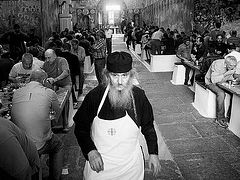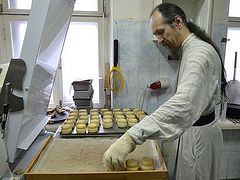St. Spyridon of Tremithus continued tending sheep even after becoming a bishop, and St. Seraphim of Sarov grew potatoes, onions and beets. The summer cottage season is approaching, and for many it is the time of gardening and landscaping. What did some saints and ascetics of piety grow? What did they feel about agricultural activities in general?
Elder Nikolai Guryanov grew gladioli and cypresses in the north of Russia
For over forty years Archpriest Nikolai Guryanov (1909–2002) served at the Church of St. Nicholas the Wonderworker on Talabsk (Zalit) Island in the Pskov region. Numerous pilgrims flocked for counsel from one of the most venerated elders of the twentieth century, a believer from childhood who had gone through the ordeal of exile in Syktyvkar.
In 1958, Fr. Nikolai began serving in the Diocese of Pskov. At his personal request, he was appointed rector of St. Nicholas Church on Zalit Island on Pskov Lake. When he arrived at the fishing island, he was met by bare, rocky ground. Although the locals were sure that the soil was unsuitable, Fr. Nikolai planted trees, shrubs, and flowers on it. To the remarks about the meaninglessness of this undertaking he would reply, “Let’s trust in the Lord—He will help us!”
Fr. Nikolai collected plants, roots of bushes and flowers from Kiev, the Pochaev Lavra, Vilnius and Pukhtitsa Convent and planted them on the island. At that time there was no water supply there yet, and batiushka would carry water from the lake himself, 100–200 buckets each day. He would water the bushes, flowers, and future trees. He planted chrysanthemums, dahlias, and gladioli around his house.
And soon thujas, silver firs, and larches showed green on the island… When Fr. Nikolai had arrived at Zalit, there was an empty place near his house without a single tree. And over time, according to the reminiscences of the elder’s spiritual children, even cypresses appeared in the yard of his modest house on the northern island.
St. Seraphim of Sarov collected moss from marshland for the harvest
One of the Russian Orthodox Church’s most beloved ascetics—venerated by the Orthodox Russian people on a par with St. Sergius of Radonezh—the founder of the Holy Trinity Convent in Diveyevo, St. Seraphim of Sarov, along with the work of prayer performed his everyday tasks in his solitary cell in his spare time. He dug a small vegetable garden his hut, where he grew potatoes, onions, and beets in the summer, and also picked and boiled goutweed. At one time, St. Seraphim even kept bees. He used moss from the marshland to fertilize the soil.
Spending his life in solitude, labors, reading, and prayer, the saint combined these with fasting and very strict abstinence. At the initial stage of his life as a hermit, Fr. Seraphim ate bread, most often stale and dry, which he took from the monastery on Sundays for the week. Tradition has it that he gave part of this weekly portion of bread to the forest animals and birds, who were tamed by the elder, loved him very much and visited his place of prayer.
He also ate vegetables from his hermitage kitchen-garden, which he cultivated so as not to burden anyone at the monastery. And following the example of the Apostle Paul, he supported himself with the labors of his hands. Subsequently, the saint trained his body to such abstinence that he no longer ate bread, but lived on only vegetables from his garden.
While toiling, St. Seraphim did not forget to lift up his spirit to God in prayer. He would say, “Work on your hands, and prayer on your lips.” Physical labor created a peaceful state in him; he sang prayers, troparia, and canons as he worked.
St. Paisios the Hagiorite planted “squid, whiskers down”
During his lifetime, Elder Paisios the Hagiorite became well known all over the world. The faithful from different parts of the globe—Australia, Africa, and the northern continents—would come to visit him on Mt. Athos. In 2015 he, our contemporary who reposed in the Lord in 1994, was canonized by the Church. Many pilgrims could observe the elder’s agricultural activities.
When the saint struggled in Panagouda Hermitage, he connected a plastic hose to one of the springs. But there was not enough water in the summer months, so the ascetic repaired an old underground cistern, which filled up during the winter. He cultivated a tiny vegetable garden, in which he planted some roots of perennial wild cabbage. In addition, every year St. Paisios grew onions, lettuce and a few tomato bushes in his garden.
One day the elder was working in his garden in Panagouda. He would take seeding-onions out of a squid can and plant them in the ground. A pilgrim with his hands clasped importantly behind his back approached the elder and asked what he was doing.
“I’m planting squid,” the elder replied.
“And do they take root?”
“Well, if you plant them whiskers down, they take root.”
The saint planted green beans in a small vegetable garden on a rocky terrace next to his cell of Stomio Monastery near Konitsa, where he struggled for several years. Once Elder Paisios spotted an unusual visitor there—a forest hare. The guest was gobbling up green beans and did not notice Elder Paisios. The ascetic sneaked up on the hare, opened the flap of his cassock, covered the hare with it and took it away from the garden. He released the bean lover with the following words: “Go away with God’s blessing, but don’t eat monastery beans anymore! Don’t you have anything to eat in the forest? After all, the Lord has given you so many different herbs and bushes! Feed on all this at your pleasure.”
St. Spyridon of Tremithus tended flocks and harvested bread
 St. Spyridon of Tremithus St. Spyridon of Tremithus, whom we see in icons wearing a shepherd’s hat, is venerated as a wonderworker along with his contemporary, St. Nicholas, Archbishop of Myra in Lycia. Through the saint’s intercessions, drought gave way to rain, and continuous rains—to dry weather; the sick were healed, and the dead were brought back to life. It was St. Spyridon who at the First Ecumenical Council in 325 A.D. demonstrated clearly Unity in the Holy Trinity against the Arians. He squeezed a brick in his hand, from which flame shot up, water poured down, and clay remained in the bishop’s hand. “These are three elements, and the brick is one,” the saint said then. “So also in the Most Holy Trinity there are Three Persons and One Godhead.”
St. Spyridon of Tremithus St. Spyridon of Tremithus, whom we see in icons wearing a shepherd’s hat, is venerated as a wonderworker along with his contemporary, St. Nicholas, Archbishop of Myra in Lycia. Through the saint’s intercessions, drought gave way to rain, and continuous rains—to dry weather; the sick were healed, and the dead were brought back to life. It was St. Spyridon who at the First Ecumenical Council in 325 A.D. demonstrated clearly Unity in the Holy Trinity against the Arians. He squeezed a brick in his hand, from which flame shot up, water poured down, and clay remained in the bishop’s hand. “These are three elements, and the brick is one,” the saint said then. “So also in the Most Holy Trinity there are Three Persons and One Godhead.”
The future saint, who lived in the third century, tended flocks of sheep and goats on the island of Cyprus from childhood. After his wife’s death, during the reign of Emperor Constantine the Great (306–337), he was elected bishop of the city of Tremithus. He did not change his way of life after receiving this rank. St. Spyridon strictly observed the church services and the Holy Scriptures in all their integrity, setting an example to his spiritual flock of a virtuous life and diligence—he tended sheep and harvested grain.
The Byzantine Christian Church historian Socrates Scholasticus, who lived in the fifth century, recounted how once thieves decided to steal St. Spyridon’s sheep. At night they broke into the sheep pen, but immediately found themselves bound by an invisible force. The saint, who came to his flock in the morning, saw the robbers tied up. He offered up a prayer, untied them and convinced them to give up their lawless way of life. As he let them go, he even gave each of the thieves a sheep and said kindly. “This is so that you did not lose sleep in vain.”
King David sang psalms and founded Jerusalem
The Old Testament Prophet David was a shepherd before being anointed king. And it was he who wrote over half of the Psalter—one of the most important books of the Holy Scriptures. It is the only book of the Old Testament to be fully included in the Orthodox Church’s liturgical cycle.
 Holy King and Prophet David In his youth, St. David tended his sheep and sang the prayers he composed, accompanying himself on a shepherd’s musical instrument called the psalterion, which is very similar to the modern harp. The verses of the Psalter have been relevant for almost 3000 years now. In his psalms, St. David predicted many events and expressed the full range of human spiritual experiences. The Psalter is regarded as a model of prayer.
Holy King and Prophet David In his youth, St. David tended his sheep and sang the prayers he composed, accompanying himself on a shepherd’s musical instrument called the psalterion, which is very similar to the modern harp. The verses of the Psalter have been relevant for almost 3000 years now. In his psalms, St. David predicted many events and expressed the full range of human spiritual experiences. The Psalter is regarded as a model of prayer.
David’s reign lasted forty years. He won battles, expanding lands for his people, and built new cities... It was he who founded Jerusalem and moved the Ark of the Covenant to it, where the Tablets with the Commandments that God had given to the Prophet Moses on Mt. Sinai were kept.
King David loved music and singing, and even after becoming king, he continued to sing and play his musical instrument. Psalm 151 very aptly conveys David’s distinctive feature: humility. Everything in the psalm from the king’s life and activity is attributed to the Lord’s benevolence. This is also how all the saints perceive everything that happens in life.
I was the smallest among my brethren, and the youngest in the house of my father; I did shepherd the sheep of my father. My hands made an instrument, and my fingers fashioned a psaltery. And who shall tell my Lord? The Lord Himself, He Himself shall hearken. He sent forth His angel and took me from the flocks of my father, and anointed me with the oil of His anointing (Ps. 151:1-4).






